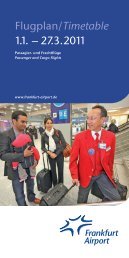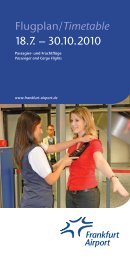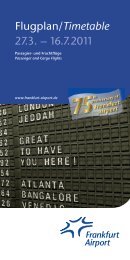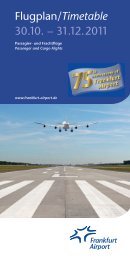FanPost Template
FanPost Template
FanPost Template
Sie wollen auch ein ePaper? Erhöhen Sie die Reichweite Ihrer Titel.
YUMPU macht aus Druck-PDFs automatisch weboptimierte ePaper, die Google liebt.
6 Nachrichten/News<br />
Auch am Boden, auf den Airports, wird mit Hochdruck an alternativen<br />
Antrieben gearbeitet oder sie werden bereits in der Praxis eingesetzt.<br />
So testete zum Beispiel die Fraport AG vier Jahre lang mittels<br />
Wasserstoff und Brennstoffzelle angetriebene Pkw am Flughafen oder<br />
setzt im Abfertigungsbetrieb bereits viele Elektrofahrzeuge ein. Die<br />
Stromversorgung von über 70 mobilen Fluggasttreppen wird von<br />
integrierten Solarzellenmodulen sichergestellt. Vor Kurzem fand auf<br />
dem Vorfeld von FRA das erfolgreiche Testrollen eines Airbus A320<br />
der Lufthansa statt, in dessen Hauptfahrwerk Elektromotoren für das<br />
ei genständige Bewegen der Maschine sorgten. Ziel der Ingenieure<br />
ist, dass Flugzeuge ohne Triebwerksschub und Kerosinverbrennen bis<br />
zur Startbahn rollen können. (L.R.)<br />
Investments in Eco-friendly Equipment<br />
At first glance, the appearance of aircraft has hardly changed over the<br />
past 40 years. From a technical point of view, however, aircraft have<br />
changed a lot during this period and will continue to change also in the<br />
future. When aircraft manufacturers, such as Airbus, Boeing, or Embraer,<br />
design new aircraft today the focus is on reducing fuel consumption and<br />
minimizing flight and engine noise. To achieve this, new engine tech nol -<br />
ogies and forms are being developed, such as serrated engine nacelles<br />
used for the brand new Boeing B787 Dreamliner aircraft.<br />
Aircraft featuring curved wing profiles with wingtip devices help to re -<br />
duce kerosene consumption and flight noise. Undercarriage covers and<br />
fuselage surfaces are also being continuously optimized. Thus, the noise<br />
footprint produced by all modern aircraft types – whether they are in the<br />
air or approaching an airport – has already been considerably reduced<br />
by 30 to 60 percent compared to previous models.<br />
Also at airports on the ground alternative propulsion technologies are<br />
already deployed or being tested. Fraport, the operator of Frankfurt Airport<br />
(FRA), has tested, for example, airport vehicles powered by hydrogen<br />
fuel cells for four years and deploys many electric vehicles for ground<br />
handling operations. In addition, more than 70 mobile passenger stairs<br />
at the airport are powered by integrated solar panels. Recently, a successful<br />
taxiing test was carried out at FRA with an Airbus A320 of Lufthansa.<br />
The Airbus was equipped with an electric nose wheel allowing the aircraft<br />
to move around the tarmac without using its main engines. Engineers<br />
aim to further develop this technology so that in the future aircraft<br />
can taxi to the runway without any engine thrust, thus reducing kero -<br />
sene consumption to zero with zero emissions.








